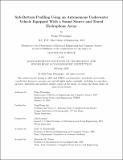Sub-Bottom Profiling Using an Autonomous Underwater Vehicle Equipped With a Sound Source and Towed Hydrophone Array
Author(s)
Pfenninger, Paige
DownloadThesis PDF (7.572Mb)
Advisor
Lin, Ying-Tsong
Leonard, John
Terms of use
Metadata
Show full item recordAbstract
Sub-bottom profiling using an autonomous underwater vehicle equipped with a source and a towed array is an excellent method to finely survey large areas of the ocean bottom with minimal interference from the water column. This approach has the benefit of being able to determine the range dependence of the sub-bottom on a meter-by-meter scale rather than assuming constant sub-bottom properties over a large range. This thesis conducts theoretical and experimental studies to investigate the feasibility of using the arrival times of acoustic signals from an autonomous underwater vehicle source to a short, 16-element towed hydrophone array to determine the sound speed and layer thickness of the seabed through Bayesian geoacoustic inversion. This method provides range-dependent geoacoustic parameters with a resolution on the order of 10 meters. Numerical studies indicate that, for timing data with low variance, arrival times can be used to accurately estimate seabed properties. However, the performance of the Bayesian inversion model deteriorates as the variance of the timing data increases. Experimental data were collected during the Seabed Characterization Experiment at the New England Mud Patch and the New England Shelf Break. This thesis attempts to improve the arrival times through the use of sub-array focusing but concludes that this method is not feasible due to the experimental data exhibiting a high level of variance in the sub-bottom timing returns, likely due to the presence of scatterers in the sediment layer. Therefore, the mean and variance of the direct path, bottom, and sub-bottom timing returns were calculated using Gaussian process regression. Furthermore, the results show that layer thickness and sound speeds are highly coupled, making it challenging to uniquely determine seabed properties.
Date issued
2025-02Department
Massachusetts Institute of Technology. Department of Electrical Engineering and Computer Science; Joint Program in Applied Ocean Science and EngineeringPublisher
Massachusetts Institute of Technology